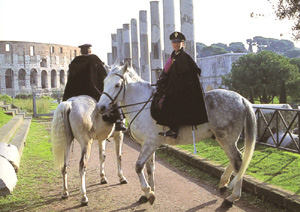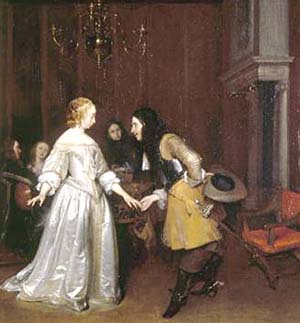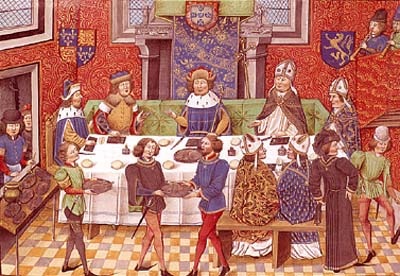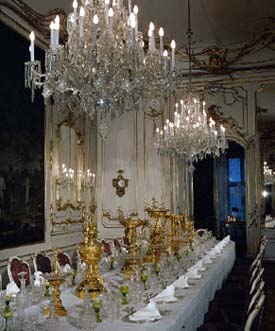 |
Manners, Customs, Clothing
Tradition, Stagnation and Progress
Prof. Plinio Correa de Oliveira
Someone asked me to explain why we should observe the traditional customs received from our ancestors. Also, why this practice is not a sign of stagnation, rancidness and mold.

The Roman police, the Carabinieri. Their uniforms reveal continuity with the past. |
Let me present some concrete customs we have received from the past, such as the rules of courtesy that still exist today. Even if they have been reduced in our days to their simplest expression, they are still an inheritance from the past. They are guidelines that provide ways to live and act that were created under the good influence of the Catholic Church or organic civil society.
Let me analyze, for instance, the custom of introducing a friend to a new acquaintance. The one introducing says to the first: “I want to introduce you to my friend X”; then he turns to the second person and says the same: “I would like you to meet my friend Y.” The two persons being introduced wait until the common friend has finished speaking and then shake hands, saying: “How do you do?” or “Pleased to meet you.” It is a practical and efficient way to introduce two persons in a new relationship.
When the persons have a certain standing in society or a profession, the one who introduces says: “I would like you to meet my friend X, who did this and that or who holds this or that position.” He provides an analogous explanation about the other person. Both parties wait with a serious and amiable air while the common friend is speaking, and then shake hands. This rite of the introduction comes from a general custom adhered to throughout Christendom. There are different formulas to follow according to the customs, social rank, and various circumstances of each people.

The Introduction by Gerard Terborch |
In Germany, until some time ago, when an inferior was introduced to a superior, he would click his heels and make a slight bow of his head. If he were introduced to a lady he would say: “Your ladyship, I kiss your hand.” The Frenchman would bend his torso, bring the lady’s hand to his lips, and then say: “Enchanté, Madame” [I am charmed, my Lady]. Other peoples had other different ways.
The rite of the introduction with legitimate variations became fixed in certain fundamental rules in each country. I imagine that so long as the world exists, these rites will continue.
Another example of a common custom is the usage and placement of silverware. The old Romans were very civilized, but did not eat with silverware. Also other peoples didn't use it. During a long time the general custom was to use a knife in one hand and bring the food to their mouth with the other. They used chalices, mugs, or cups for water or wine; they would drink soup straight from the bowl.
It was the Venetians who introduced the fork and spoon as eating utensils in the West. By the 7th Century, royal courts of Bizantium had begun to use forks at the table for dining. The custom, however, only received widespread acceptance in the West in the 1500s. It is difficult to believe that mankind took so long to introduce such a simple thing.

A royal banquet of the Duke of Lancaster in the mid-14th century still shows a table without forks - Froissart's Chronicles, 14th c. |
Later, a certain way of placing the tableware around the plate developed: the dessert silverware was set above the plate and the silverware for the main course on either side of it; the glass or goblet was placed at the right in front of the plate, easily in reach of the right hand. This way of eating and placing things on the table improved with time and then also became fixed. Unless the hippy revolution comes to dominate the whole world, this way to set the table will continue.
Fixed customs were also established in the marriage ritual. The bride enters the church wearing a white veil on the arm of her father. The groom waits for her in the presbytery. When the father and daughter approach the presbytery, the father takes his daughter’s arm from under his and gives her hand to her future husband, who then leads her to the altar.
There are reasons for these customs: the white veil represents virginity, to indicate that the bride was pure before her marriage and will now turn all her affections toward her husband and children. The fact that her father walks her to the altar affirms that he is the head of the family, the one responsible for the bride until the last moment. At the presbytery he confides his daughter to her future husband as if to say: “I am passing the authority I have over her to you. I trust you to take the same good care of her as I did.”
The use of shoes is another custom and tradition. There are peoples who walk barefooted. Others, like the Egyptians or Romans used sandals; the Chinese or Hindus used some sort of slipper; yet others used different protection for their legs and feet like the Mongolians or Eskimos who used footgear that look like our boots. But none of them offered a full protection for the feet. It was in the countries of Christendom that a shoe was created which protects the entire foot; and its use was adopted and it became the norm. Also, the use of buttons, which became generalized in the Middle Ages, is a Catholic tradition. The ancient peoples did not use them.

Rules for table settings gradually became established in the West. Above, the reproduction of a banquet of Emperor Franz Joseph |
Breakfast was also a tradition established in the West. The habit to take bread with butter and coffee, or tea with milk, in the early morning became the general practice in most of the Latin and German countries. In the Anglo-Saxon countries they adopted the practice of taking a stronger meal at breakfast, adding ham, cheese, eggs, juices and jellies. For practical reasons they acquired this tradition, one that continues to our day.
There are countless other such customs that I could list. Most of the things that we do in our daily lives follow procedures that come from the past. They are habits and customs that were created throughout the centuries and that should continue in Western Civilization with small variations according to customs of this or that people.
These traditions are not linked directly to the law of God or Morals, but reflect the good ways of living of different peoples. They have a profound relation to the natural order of things in its immutable points. For this reason, when a great people or institution adopts a custom, it is because its efficiency was already tested and approved for generations as a good or even excellent way to act in a concrete situation.
Therefore, a great people or institution normally has a large stock of these wise customs that come from the past and have the natural tendency to continue into the future. Such customs confer a tone of stability to that people or institution. Things become fixed in a certain way because they work well that way. One may change the custom, but only to improve it, not to destroy it.
Someone can object that this produces stagnation because nothing changes in the essence of the past. I think that this is rash judgment. These traditions do not get moldy, they constitute an acquired patrimony of wise practices and customs that prevent a people from redoing time and again what their ancestors had already done well. To be constantly doing and redoing the same thing is what keeps a people in the same stage of development and produces stagnation. Instead, when one accepts established solutions for problems, he is free to accomplish new things in other fields. This is the way a people progresses and rises to a higher level of civilization.
In the 16th century, for example, Spain and Portugal were able to enter the heroic age of discovery with their navigations that permitted them to discover the New World and the maritime route to India. They were able to do this because of the order and stability in their societies. Most of the social, political, and economic problems had been suitably resolved in their countries because they had the good sense to follow the traditions inherited by their ancestors. If they would have tried to redo all their customs and traditions, they would never have had the energy and time to advance in navigation.
Therefore, when acquired customs and traditions are followed in a country or area, conditions exist for creative additions in other unexplored areas. This is not stagnation or attachment to a moldy past. This is to be wide open to an authentic and stable progress. It is a point that seems indispensable to understand in order to evaluate the value of tradition.
On the other hand, to be constantly changing everything is to doom society to instability, always remaining at the same level of civilization or falling into decay.

Posted January 12, 2006

Related Topics of Interest
 Manners Make Life Easier Manners Make Life Easier
 Courtesy in the Catholic Home Courtesy in the Catholic Home
 Revolution and Counter-Revolution - Overview Revolution and Counter-Revolution - Overview
 Revolution and Counter-Revolution in the Tendencies, Ideas and Facts Revolution and Counter-Revolution in the Tendencies, Ideas and Facts
 How a Few Catholics Can Represent the Ensemble How a Few Catholics Can Represent the Ensemble
 The Immaculate Character of the Catholic Church The Immaculate Character of the Catholic Church

Related Works of Interest
|
Manners | Cultural |
Home | Books | CDs
| Search | Contact Us
| Donate

© 2002- Tradition in Action, Inc. All Rights Reserved
|
 |

|